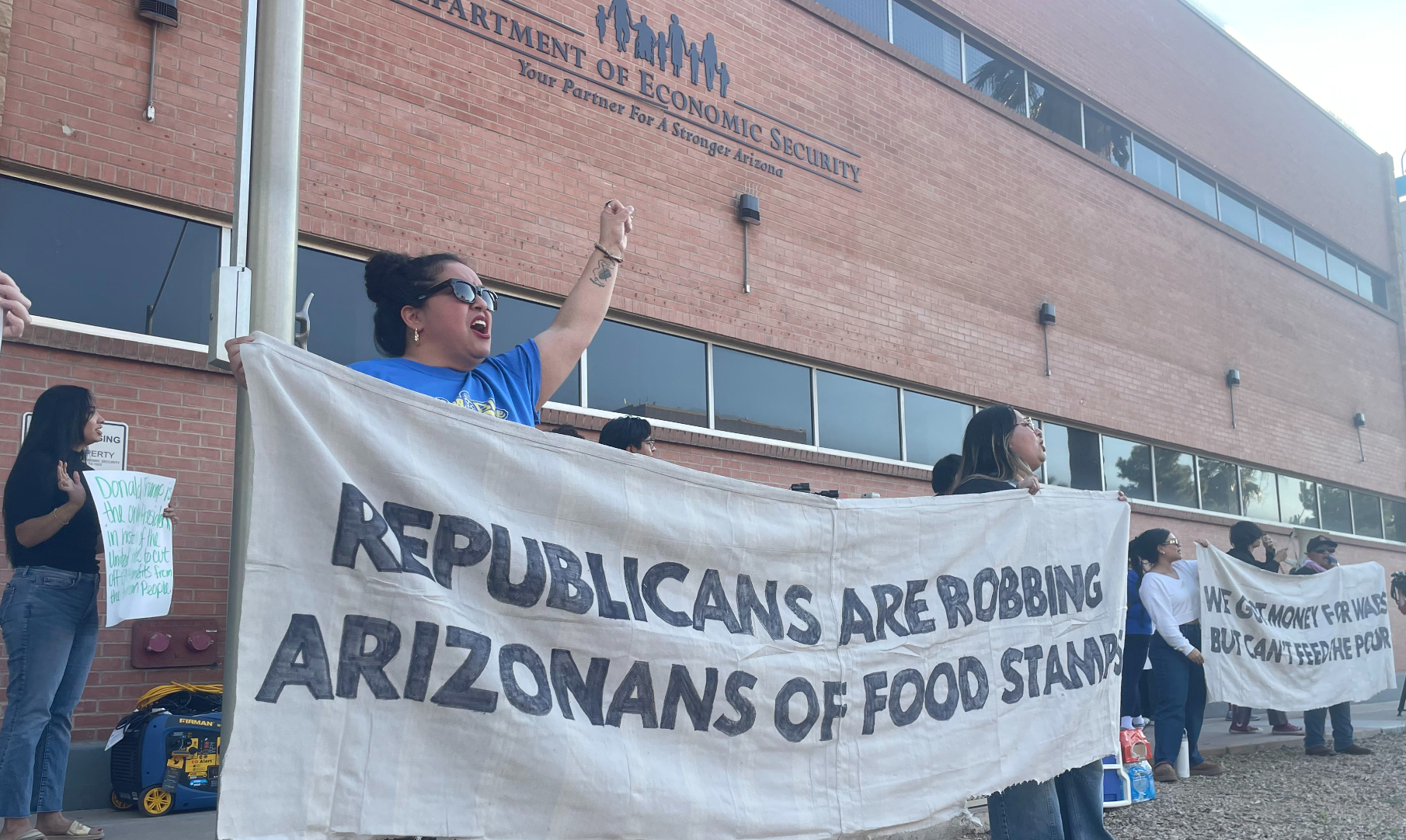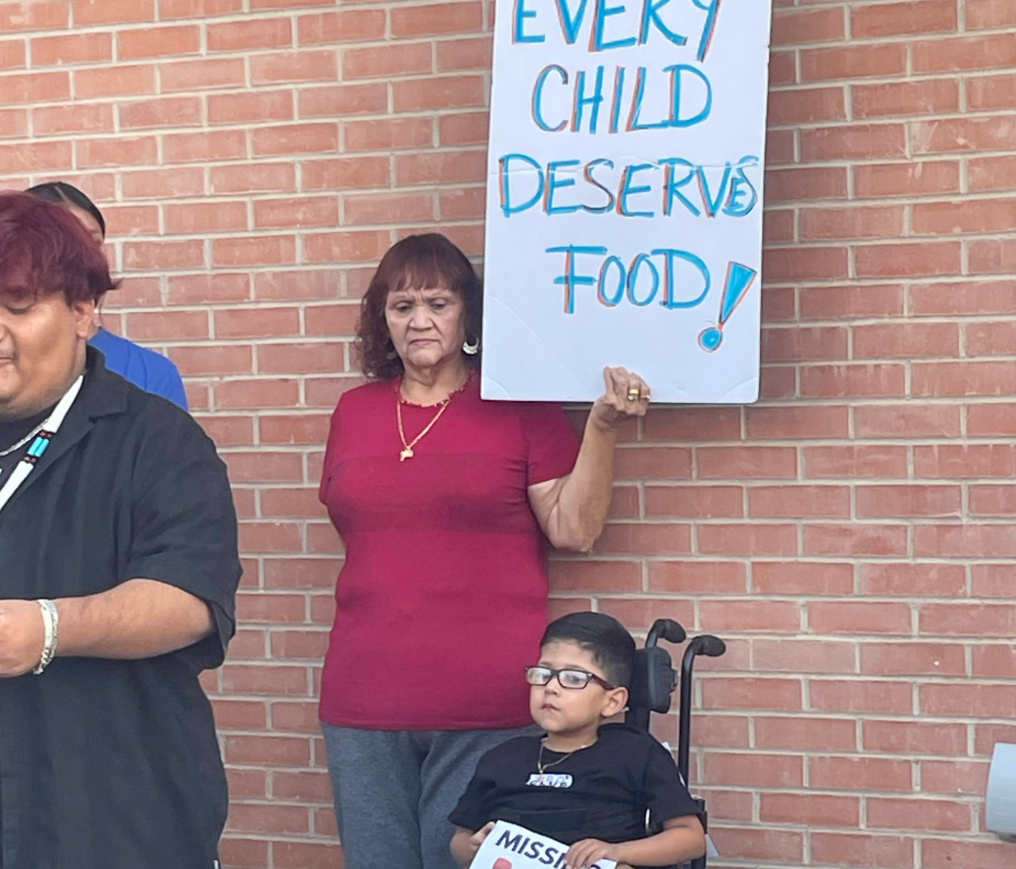
Morgan Fischer

Audio By Carbonatix
A 68-year-old grandmother leaned against the metal railing near the entrance of Arizona’s Department of Economic Security building in downtown Phoenix to support her ailing back. In less than two days, the benefits allocated from this building that she counts on to feed her family were set to expire.
For much of her life, Lena Vilna has relied on the federal Supplemental Nutrition Assistance Program to feed her family. Without a high school diploma, she worked at Kmart and Walmart while raising five of her grandchildren on her own. She relied on SNAP to feed them. Those kids are adults now — and Vilna is now retired, living on a tight fixed income. She lives with one of her daughters in a two-bedroom apartment in central Phoenix and cares for her three grandchildren. The youngest, who is 6 years old, was born with spina bifida. He uses a wheelchair to get around.
A typical family like Vilna’s, which follows a low-cost plan, spends about $1,350 a month on food, according to the U.S. Department of Agriculture. But Vilna’s family receives just $800 a month on their EBT card to spend on groceries. Vilna makes most of the family’s meals out of simple ingredients: beans, potatoes, rice. Chicken is an occasional treat.
“We don’t have extra money for food. We need this money,” Vilna said, adding that most of her daughter’s money goes to rent and electricity. “We’re not misusing it or anything.”
This year, make your gift count –
Invest in local news that matters.
Our work is funded by readers like you who make voluntary gifts because they value our work and want to see it continue. Make a contribution today to help us reach our $30,000 goal!
But the humble safety net that keeps Vilna and her family afloat is in trouble.
Amid the ongoing shutdown of the federal government, the decades-old program is set to run out of funds by Nov. 1. The Department of Agriculture has a rainy-day fund it could tap, but the Trump administration announced it wouldn’t use it to cover the shortfall. Nearly 900,000 families like Vilna’s in Arizona will be forced to scramble to figure out how to eat.
Arizona Gov. Katie Hobbs allocated $1.8 million in American Rescue Plan Act funding to help families who may lose access to SNAP, but this is just “a drop in the bucket,” she told reporters Thursday. Some $1.5 million of it will be sent to the state’s food banks. Another $300,000 will be deployed through the state’s Food Bucks Now program. SNAP recipients will be able to get a $30 one-time voucher at participating grocery stores and farmers’ markets.
Relief may be on the horizon: In a ruling Friday afternoon, federal judges in two separate cases ordered the Trump administration to continue paying for food stamps with the emergency reserve during the shutdown. But with benefits set to expire Saturday morning, it’s unclear if the Trump administration will comply and, if it does, when recipients will receive access to their SNAP funds. Trump administration lawyers suggested that it could take weeks to disburse SNAP funds after the pause. And if the Department of Justice decides to appeal the ruling, hungry Americans could be left waiting longer still.
The delay could be devastating for hundreds of thousands of Arizona families.
“People are making really difficult choices,” Nate Smith, the CEO of Central Arizona Shelter Services, told Phoenix New Times at a food drop-off event in Sunnyslope. “What we’re finding is that now people are going to choose their most immediate need — food — rather than something they can postpone — housing, which is going to increase housing insecurity and make, unfortunately, more families and individuals homeless.”

Morgan Fischer
Survival mode
As the future of SNAP remains uncertain, Vilna and other recipients are in survival mode.
Vilna’s family already made a trip to Phoenix’s largest food bank, St. Mary’s Food Bank of Arizona, to ensure their refrigerator isn’t empty. The facility in Maryvale serves more than 250,000 meals and feeds some 11,000 to 13,000 families each day, a number that has been rising since the government shutdown began 30 days ago.
On the final two days before federal food stamps were set to expire, SNAP recipients waited in lines of cars that stretched past the three lanes in the parking lot onto the street to get food before the money on their EBT cards ran out. The line, stretching several blocks into Thomas Road, left some recipients waiting as long as an hour.
“I kept turning the car off because I can’t afford the gas,” Vilna said of her trip to St. Mary’s. “And we rolled down the windows because the air conditioning uses gas.”
One driver, a 50-year-old woman named Rosario, told New Times near the front of the St. Mary’s line that she’d been there for an hour and had to circle the building five times before she was even able to make it into the line. Rosario, who works as a cashier, made a trip out to the food bank on Thursday morning after her employer significantly cut her hours, leaving her in dire straits.
“The economy is hitting us so hard,” Rosario said. “A lot of people have lost their jobs, they don’t work a lot of hours and they need food to take in to their family.”
Further down in St. Mary’s line, Corina Betancourt sat with her aunt in a beat-up black sedan. The car was missing a front bumper and had knife-like scratches to its hood. Betancourt hasn’t paid it off but plans to trade in the car, which will mean more car payments. She worried about money as she made the trip to get groceries because her food stamps won’t be renewed on Nov. 1.
Like Rosario, Isidoro Hernandez, 64, made three trips around the building before he got into line. He came out to St. Mary’s after learning that his SNAP benefits wouldn’t be renewed. The trip is routine for him. He comes to the food bank a couple of times a month, as the rice and cans of beans he receives last him two or three weeks. Sometimes he’ll get chicken or broth. Since retiring two years ago, he has lived off a fixed income and $90 a month from SNAP.
“Sometimes it can only mean a cup of potatoes for a meal,” Hernandez said. As for his fixed income, he said, “I take it to pay my bills and my rent — that’s it.”